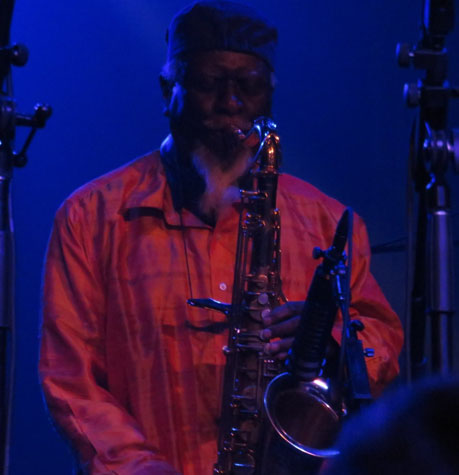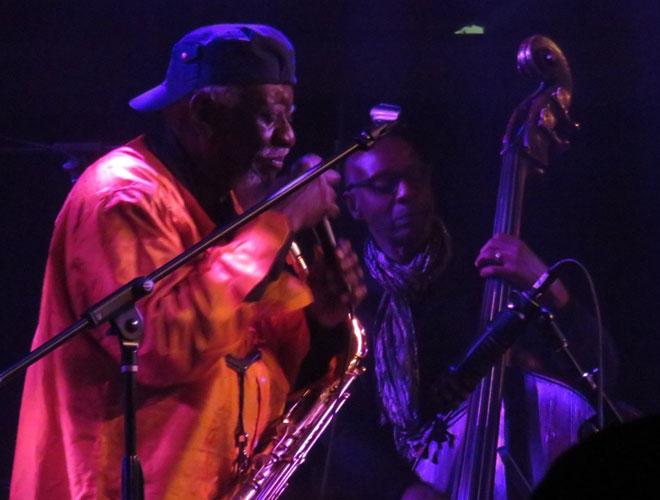PHAROAH SANDERS

Live at Red Bull Music Academy, New York, May 2016- photo by Jason Gross
Tribute by Fabio Rojas
(December 2022)
The Creator has a master plan and it includes Pharoah Sanders. For over eighty years, Sanders brought his wisdom and vision to our musical world. On September 24, 2022, he joined the ancestors.
The Tone
I can tell you immediately if Pharoah Sanders is on a recording. Most jazz fans can. Sanders' main mode of expression was the tenor saxophone and the horn breathed fire in his hands. It was an unmistakable flame that was his alone. But what exactly was that sound, that wail into the void? It had layers. At the foundation was a rich bluesy open tone, common to jazz saxophonists of the era. All the great tenors had it. Coleman Hawkins had it. Sonny Rollins had it and so did Lester Young. And, of course, John Coltrane had it.
The free jazz generation added so much to this foundation. Among the tenors, we had Trane and Albert Ayler. With Sanders, they delved into dissonance and multiphonics. It wasn't sonic anarchy though. The free jazz tenors definitely enjoyed uncontrolled blasts, but most of the time, they were expanding their sonic palette. Ayler, in my view, treated sound distortion as a trigger for emotional responses. When I listen to Ayler in his most well-known recordings, such as Spiritual Unity, the screams recall religious outbursts. Trane relied on multiphonics to create another dimension to his harmonic explorations. Not only did he innovate chord progressions, he was able to play multiple notes at once.
Sanders took a different approach. He used growls, distortions, and multiphonics to evoke groundedness. His tone was sharp, but also warm and inviting, like a special message from space. His song and album titles often evoked this aesthetic: "Astral Traveling," Karma, Journey to the One.
Apprenticeship
The musical world first became aware of Sanders when he joined the John Coltrane group in 1965. Sanders appeared at a time when Coltrane's music was undergoing rapid and profound musical development. When Trane emerged as a leader, he focused on post-bop music that employed speed and harmonic complexity, while the classic quartet was most well-known for modal compositions, drones, and vamps that allowed pianist McCoy Tyner and Trane to build up rhythmic and chordal density. After Tyner and drummer Elvin Jones left the group, Trane decided to incorporate religious elements, focus on free pulse, and increase the aural density of the music to an even higher level. Sanders was an ideal collaborator for this group. Within the free flowing, but extremely dense, soundscape created by pianist Alice Coltrane, drummer Rashid Ali, and quartet hold-over bassist Jimmy Garrison, Sanders could project well and stay rooted to some emotional themes and melodic lines, even when played with his characteristic intensity.
My favorite recording from this period is Live in Seattle, originally recorded in 1965 and released in 1971. This record really exemplifies Sanders' ability to stay focused, and beautiful, in the maelstrom of the last Coltrane ensemble. The initial track, "Cosmos," illustrates this well. As expected, Coltrane's solo displays a logical coherence and intensity, but Sanders's solo, equally intense, is more direct and straightforward, a perfect compliment. The entire album is exploratory in feeling. The liner notes observe that the recording is incomplete as the tape literally ran out. That's OK. The fade out makes it sound as if they have left for an extended cosmic journey.
Groove
After Coltrane's death, Sanders became a focal figure in contemporary jazz, appearing on dozens of albums as a leader and a collaborator. The list of partners is a musical hall of fame: Alice Coltrane, Sun Ra, Don Cherry, Kenny Garrett, and so many more. While he stayed true to his free jazz roots, Sanders was always able to productively work in a constantly changing music environment.
Message From Home (1996) is one of Sanders' lesser known albums but it has a special place in my heart. Most of the album is highly produced and sounds very slick and electronic, but the first track is outstanding. It starts with a drum kick followed by a deep bass groove. Sanders plays some lines that live in the smooth jazz zone. Then there is a chant - "Our roots began in Africa! Our roots Began in Africa!" Classic. It's about beginnings, it's about music, it's about how our entire species branches out from a single grooving root. Majestic!
Higher Planes
The highly lauded 2020 album Promises on the Luaka Bop label is Sanders' last album, recorded at age eighty one. That, by itself, teaches us a very profound lesson. Stay in good health and be active, and we can contribute for as long as the Creator allows us to walk the earth. The album is recorded with electronic musician Sam Shepherd, also known as Floating point, and the London Symphony Orchestra. Jazz has an honorable history of musicians who play "with strings," but Promises takes this to an entirely different level.
It's hard to describe Promises, but it is reasonable to say that the music features Shepherd's minimalist and ambient compositions with Sanders playing over the electronica and the orchestra. In classic minimalist fashion, the London Symphony Orchestra plays straightforward lines with varying harmonic movements with varying emotional resonances. Shepherd adds layers of digitally produced effects. One wonders if Sanders' playing is freely improvised or if he's responding to a score, or chord progression, written by Shepherd, but it's effective.
To see what actually happened there, Luaka Bop president Yale Evelev lays out the scene for us of how it all came about:
We worked for about five years to get this record to happen, After my co-worker Eric played Pharoah Sam's first record we were about to put out, and Pharoah liked it. They were in Eric's rent-a-car, smoking a joint at the time.On Promises, sometimes Sanders seems to be working in a traditional call and response mode, while at other points, he plays "above" the music or he enters and exits the sonic space created by Shepherd and the orchestra. The listening experience is akin to observing a complex landscape. Mountains ebb and flow. Plants and animals follow their own logic. All we can do is fall under their spell.Pharoah shows up at the studio and says "what are we going to do?" Sam says, "that's what I was going to ask you." We knew we wanted to make a record with the two of them but none of us knew what that record would be.
So Sam tells Pharoah to go home and come back in a couple of days. When Pharoah comes back, they try a couple of things together, among them Sam plays Pharoah a seven-note loop he made and says, "why don't you play over this?" Here is that actual moment, when you hear Sam say, "see you in 40 minutes."
This album is a fitting capstone to an astounding career. It represents a genuinely new and interesting twist in Sanders' music. In the 1960's, Sanders focused intensity represented a sort of simplification of Coltrane's extreme musical density. In contrast, Promises situates Sanders as an ornamentation, or a rejoinder, to the minimalism found in Shepherd's music. The physical packaging of the music underscores this point. Julie Mehretu, one of the leading visual artists of the early 21st century, contributed an illustration. Known for cityscapes that float and deconstruct into multiple visual planes, Mehretu's art is a perfect companion to the music.
Of the Ages
I conclude this homage with a few words about a recording called Ask the Ages. It's a quartet - Sanders plays with Elvin Jones, Charnett Moffett, and Sonny Sharrock (who's credited with the release). The music is rather conventional by most standards and he group plays pretty melodies on top of solid grooves and occasionally delves into "blow out" territory. Despite a "straight ahead" foundation, the music reaches its full potential as a somewhat somber, somewhat joyful melodic balance. This music calms and heals. It has made my life in this realm better. Thank you, Mr. Sanders.

Live at Red Bull Music Academy, New York, May 2016- photo by Jason Gross